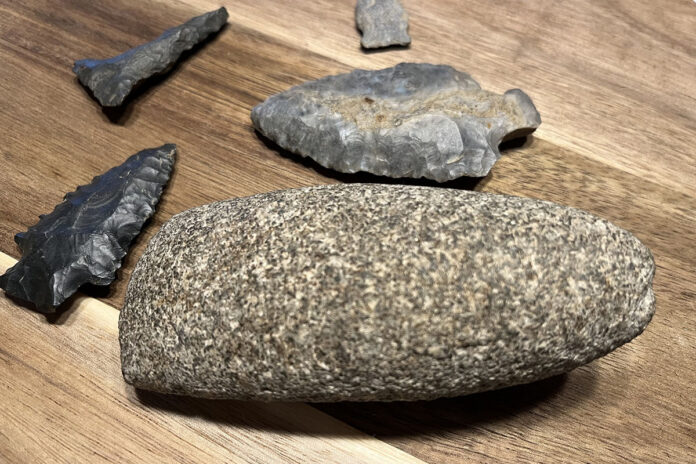
People can be divided into one of two groups in November. I don’t mean political parties either. It’s an issue far more divisive than politics. The biggest debate is about Christmas decorations.
I dig in my heels and wait until the day after Thanksgiving. My friend had her Christmas tree up in October. I questioned our friendship.
I like to savor every part of Thanksgiving: Gratitude, tradition and gathering with family and friends make the holiday special every year. The next day I clean and then decorate for the Christmas season.
For my two sons, the most exciting part of November is deer hunting. My oldest son was determined to harvest a buck with his bow. He spent a few weeks observing the habits of the deer in our woods.
After a few missed opportunities, he heard a buck in the distance. He called it in closer and was able to shoot it with his bow. My younger son is waiting for youth weekend with a gun.
Ancient arrowheads
Eating wild game seems fitting for this month. However, one thing we have not focused on before is studying local history, specifically studying the Native Americans of the area. I thought it would be a great time to show our kids their great-grandfather’s arrowhead collection.
Carl Lipp was born on his family farm in Unity Township in 1924. Over the years, he collected many arrowheads and Native American artifacts from the fields.
When he was old enough to help with the farming, he walked behind their team of horses and a plow. Years later, when the first tractor was purchased for the farm, he used a two-bottom plow.
He found the majority of the arrowheads in May or June. In the springtime, organic matter was chopped down when the field was turned over and the topsoil was flipped in the plowing process. The upheaval caused by the freezing and thawing of the soil throughout the winter and early spring pushed rocks to the surface.
After the largest rocks were removed, the seedbed was prepared for planting by discing the field. If it happened to rain on the flattened field, the shiny flint of an arrowhead stood out against the brown dirt. Even a light mist made arrowhead hunting easier.
As Carl aged and became a father and later a grandfather, he passed his love of finding arrowheads to the next generation. The past few decades have not yielded nearly as many arrowheads. Farming in our area has transitioned to no-till methods. The topsoil is not turned over, limiting the exposure to artifacts.
Native Ohioans
My kids and I compared the different shapes and sizes in his collection. The colors vary depending on the type of flint used. The flint types most commonly used in Ohio are Flint Ridge, Coshocton, Nellie Chert, Zaleski and Indiana Hornstone.
Lighter in color with shades of pink, Flint Ridge flint is Ohio’s official gemstone. The other types of flint range in color from light gray to glossy black. One arrowhead in the collection made from Coshocton flint had streaks of quartz in it, giving the appearance of a lightning bolt.
Images of Thanksgiving capture the likeness of tribes that were in the area at the time of European settlement. When Europeans arrived in Ohio, the largest Native American cultures present at the time were mainly Iroquois and Algonquians. The native groups living in Ohio were related to these two opposing groups often at war with each other.
Many of the arrowheads in our collection date back much farther to the Adena culture. The Adena culture is known for its mound building and occupied Ohio from 500 BC to AD 100.
Untouched
At some point, Carl even found an Adena celt, an ax-like object often used for chopping down trees. The stone blade was fitted into the handle instead of being attached to it. My boys turn the celt over in their hands and can’t even fathom what life was like at the time of its use. They can’t imagine hunting with ancient arrows.
With many arrowheads and Native American artifacts found in fields, there is a large likelihood that the last person to have touched it was the creator of it. That is a heavy thought.
An artifact can be untouched by human hands for a couple of thousand years and then brought to the surface. Images pass through my mind like a time machine on hyperdrive as I think back on all the events that transpired in that expanse of time.
It makes certain arguments seem trivial, like when to decorate for Christmas. It also makes time spent with friends and family even more precious.
Even during a time of conflict and turmoil, we have many blessings to be thankful for.












